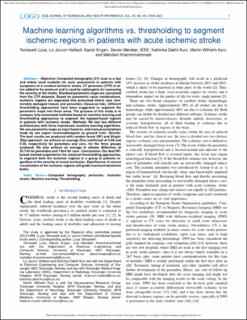| dc.contributor.author | Tomasetti, Luca | |
| dc.contributor.author | Høllesli, Liv Jorunn | |
| dc.contributor.author | Engan, Kjersti | |
| dc.contributor.author | Kurz, Kathinka Dæhli | |
| dc.contributor.author | Kurz, Martin Wilhelm | |
| dc.contributor.author | Khanmohammadi, Mahdieh | |
| dc.date.accessioned | 2021-12-14T14:14:38Z | |
| dc.date.available | 2021-12-14T14:14:38Z | |
| dc.date.created | 2021-12-02T16:27:39Z | |
| dc.date.issued | 2021-07 | |
| dc.identifier.citation | Tomasetti, L., Høllesli, L.J., Engan, K., Kurz, K.D., Kurz, M.W., Khanmohammadi, M. (2021) IEEE journal of biomedical and health informatics | en_US |
| dc.identifier.issn | 2168-2194 | |
| dc.identifier.uri | https://hdl.handle.net/11250/2834249 | |
| dc.description.abstract | Objective: Computed tomography (CT) scan is a fast and widely used modality for early assessment in patients with symptoms of a cerebral ischemic stroke. CT perfusion (CTP) is often added to the protocol and is used by radiologists for assessing the severity of the stroke. Standard parametric maps are calculated from the CTP datasets. Based on parametric value combinations, ischemic regions are separated into presumed infarct core (irreversibly damaged tissue) and penumbra (tissue-at-risk). Different thresholding approaches have been suggested to segment the parametric maps into these areas. The purpose of this study is to compare fully-automated methods based on machine learning and thresholding approaches to segment the hypoperfused regions in patients with ischemic stroke. Methods: We test two different architectures with three mainstream machine learning algorithms. We use parametric maps, as input features, and manual annotations made by two expert neuroradiologists as ground truth. Results: The best results are produced with random forest (RF) and Single-Step approach; we achieve an average Dice coefficient of 0.68 and 0.26, respectively for penumbra and core, for the three groups analysed. We also achieve an average in volume difference of 25.1ml for penumbra and 7.8ml for core. Conclusions: Our best RF-based method outperforms the classical thresholding approaches, to segment both the ischemic regions in a group of patients regardless of the severity of vessel occlusion. Significance: A correct visualization of the ischemic regions will guide treatment decision better. | en_US |
| dc.language.iso | eng | en_US |
| dc.publisher | IEEE | en_US |
| dc.rights | Navngivelse 4.0 Internasjonal | * |
| dc.rights.uri | http://creativecommons.org/licenses/by/4.0/deed.no | * |
| dc.subject | medisinsk teknologi | en_US |
| dc.subject | hjerneslag | en_US |
| dc.subject | MRI | en_US |
| dc.subject | maskinlæringsalgoritmer | en_US |
| dc.subject | CT | en_US |
| dc.title | Machine learning algorithms vs. thresholding to segment ischemic regions in patients with acute ischemic stroke | en_US |
| dc.type | Peer reviewed | en_US |
| dc.type | Journal article | en_US |
| dc.description.version | publishedVersion | en_US |
| dc.subject.nsi | VDP::Teknologi: 500::Medisinsk teknologi: 620 | en_US |
| dc.source.pagenumber | 13 | en_US |
| dc.source.journal | IEEE journal of biomedical and health informatics | en_US |
| dc.identifier.doi | 10.1109/JBHI.2021.3097591 | |
| dc.identifier.cristin | 1963737 | |
| cristin.ispublished | true | |
| cristin.fulltext | original | |
| cristin.qualitycode | 1 | |

